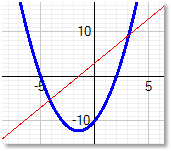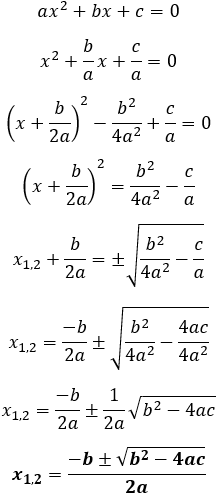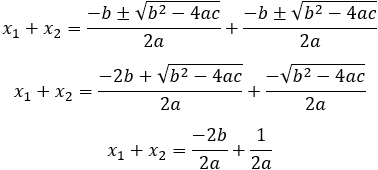Quadratic, Cubic, Quartic Equations calculator

Quadratic, cubic, quartic equations summary

Quadratic equation is of the form: f(x) = ax2 + bx + c = 0
This equation has two solutions defined by:

The value under the root: b2 - 4ac is called the discriminant (Δ).
When Δ > 0 then two real solutions exist.
When Δ = 0 then one real solution exists.
When Δ < 0 then two complex solutions exist.
The roots are related to each other by the formulas:

To find the extreme points of the graph we must
find the first derivation of the function and compare it to 0.

To find if the extreme point is a maximum or minimum of
the graph we must find the second derivation of the function.

If f '' > 0 then the extreme point is a minimum.
If f '' < 0 then the extreme point is a maximum.
Example 1: Find the extreme point of the function f(x) = x2 + 3x - 10 = 0

The solutions of the function are:


First derivation is: f ' = 2x + 3 = 0 extreme point at x = -1.5
Second derivation is: f '' = 2
because f '' >0 the extreme point is a minimum.
Example 2: Find the extreme points of the function f(x) = 4x4 + 4x3 - 11x2 + 2x + 10 = 0

The solutions of the equation are: −0.849, −2.139, 0.994 ± i0.623

First derivation is: f ' = 16x3 + 12x2 - 22x + 2 = 0
(This curve is sketched by the red line)
The solutions of first derivation will give us the extreme points
which are at: x1 = -1.64, x2 = 0.1 x3 = 0.79
To find if the points are a maximum or minimum, we
shall find the second derivation: f ''(x) = 48x2 + 24x - 22
Now substitute each extreme point to the second derivation:
f '' (x1) = 48 * (-1.64)2 + 24 * (-1.64) - 22 = 67.7
f '' (x2) = 48 * 0.12 + 24 * 0.1 - 22 = -19.1
f '' (x2) = 48 * 0.792 + 24 * 0.79 - 22 = 26.9
x1 - is minimum, x2 - is maximum, and x3 - is minimum.
Example 3: Find the quadratic equation if we know that the roots are 2 and 3.

The general form of the quadratic equation is found by the following steps.


(1)
Now we can add and multiply solutions (1) to get the result of x1 and x2 as a function of the coefficients a, b and c as follows.


(2)


(3)
Substitute given solutions x1 = 2 and x2 = 3 into equations (2) and (3).
b = −(x1 + x2)a = −(2 + 3)a = −5a
c = x1x2a = 2 ‧ 3a = 6a
If we chose a = 1 than the quadratic equation will be: x2 − 5x + 6 = 0
